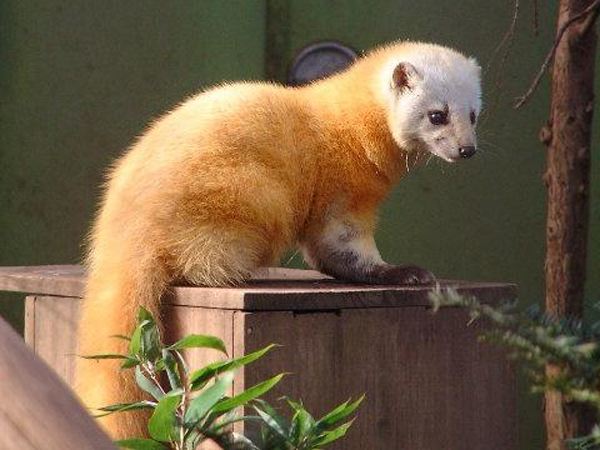Martes melampus
IUCN
LCBasic Information
Scientific classification
- name:Martes melampus
- Scientific Name:Martes melampus,Japanese Marten
- Outline:Carnivora
- Family:mustelidae mustelinae marten
Vital signs
- length:47-54.5cm
- Weight:500-1700g
- lifetime:8-12years
Feature
Fur coloration ranges from yellow-brown to dark brown with white to cream patches across the neck
Distribution and Habitat
The Japanese marten is found in Honshu, Shikoku, and Kyushu in Japan. In 1949, it was introduced from Honshu to Sado and Hokkaido in order to increase the production of fur products. It is found in southwestern Hokkaido, especially in the Oshima Peninsula and Ishigaki and Tsushima Islands, but research is needed to confirm the exact area of its distribution. It is also sparsely distributed on the Japanese Tsushima Islands. The Japanese marten found on the Korean mainland belongs to the Korean subspecies.
The Japanese marten is a species that lives in alpine forests and moves along valleys, mainly in broad-leaved forests (dominated by plants of the genus Quercus and Castanopsis microphylla of the family Fagaceae). The species also lives in coniferous plantations and open fields. It digs burrows at the roots of trees and underground. The number distributed in the Tsushima Islands accounts for 88% of the total, where the average temperature in January is 4°C, the average high tempera
Appearance
Japanese martens are small to medium-sized mammals. The weight is 500-1700 grams, the body length is 470-545 mm, and the tail length is 170-223 mm. The body is slender and the limbs are short. The head is long and narrow, the ears are generally short and round, and the sense of smell and hearing are sensitive. The canine teeth are more developed and the cleft teeth are smaller; the upper molars are arranged horizontally, and the inner leaves are wider than the outer leaves; the crown diameter of the molars is greater than the height of the outer incisors. Both front and rear feet have 5 fingers (toes); they are plantar; the claws are sharp and cannot be retracted. The tail is thick and fluffy. There are odor glands near the anus, which can release odor to repel enemies and defend themselves.
The age of a Japanese mink is determined by the wear and tear of its teeth. There is a large gender difference, with males being larger. The weight of adult minks ranges from 500-1700 grams. The
Details
Japanese Marten (scientific name: Martes melampus) has three subspecies.

Subadult Japanese martens generally establish territories immediately after maturity. The average area for males is 0.70 square kilometers, and the average area for females is 0.63 square kilometers, with less than 10% overlap between the two families. Relatively small family size, preferred habitat depends on food abundance and distribution. Distributed around the perimeter of the home range, mainly in circular formations. Common social behaviors in the wild Japanese marten include scent marking and maintaining boundaries.
Japanese martens have been observed leaping from the ground to trees up to 2 meters in height. Nocturnal, do not hibernate. Omnivorous. Highly diverse diet throughout the year. Important foods are fruits and berries from spring to fall, insects in summer and fall, small mammals and birds eaten year-round. May also compete with other carnivores for small mammals, feeds on insects, worms, rodents, and birds, and also eats plant fruits and seeds, including wolfberry, kiwi, reed, elm, eucalyptus, banyan, and pumpkin.
Japanese martens forage for local fruits and berries. In case of interspecific competitors or human disturbance, they switch to alternative food resources, making them more adaptable than Siberian ferrets and the Philippine and Bangladeshi minks.
Japanese minks reach sexual maturity at 1-2 years of age. They are seasonal breeders, mating from late March to mid-May and giving birth between mid-July and early August. Embryonic diapause may occur. They produce 1-5 pups per litter, with an average of 1.5. They reproduce iteratively. They use rock and tree holes as nests. Both females and males reach reproductive maturity at 1 to 2 years. The young are very important and are cared for by the mother. Like all mammals, the mother mink feeds her young with milk. Japanese minks are born deaf and dumb. Young minks grow up to kill prey at 3-4 months of age and leave their mothers shortly thereafter.
Listed in the 2015 IUCN Red List of Threatened Species ver3.1 - Least Concern (LC).
Protect wild animals and eliminate game.
Maintaining ecological balance is everyone's responsibility!








